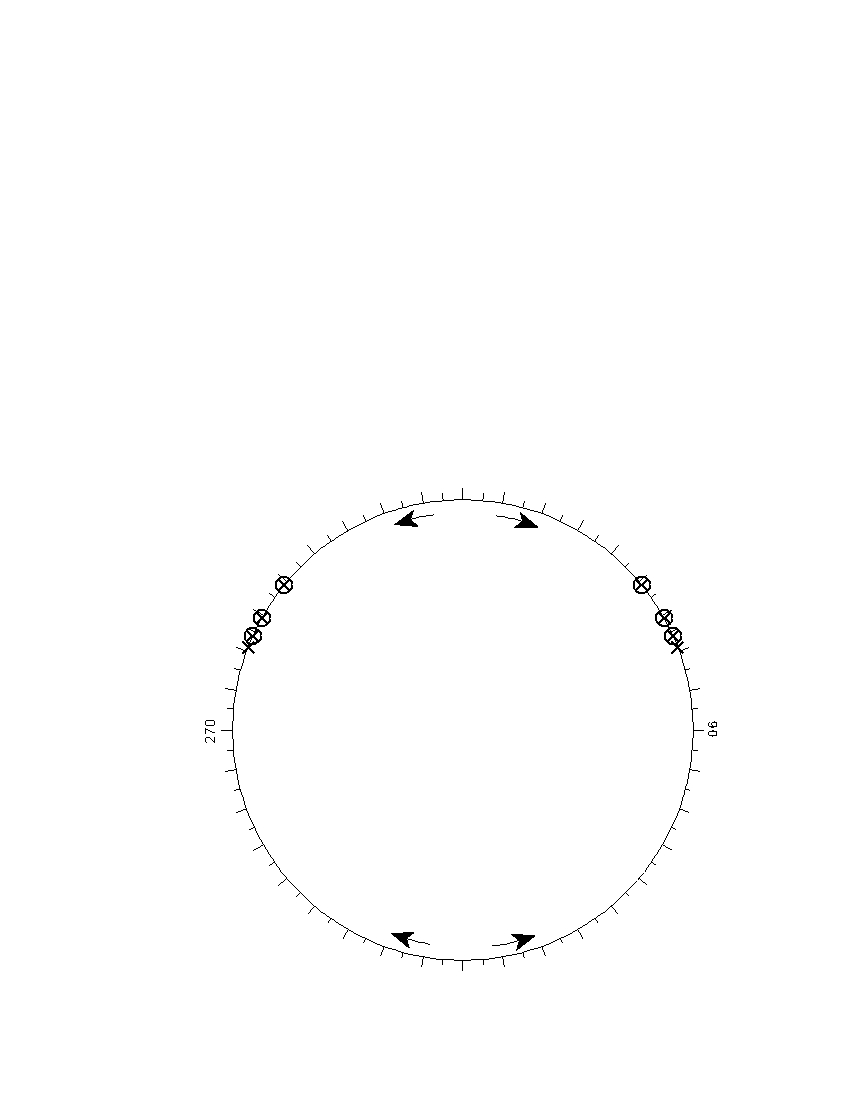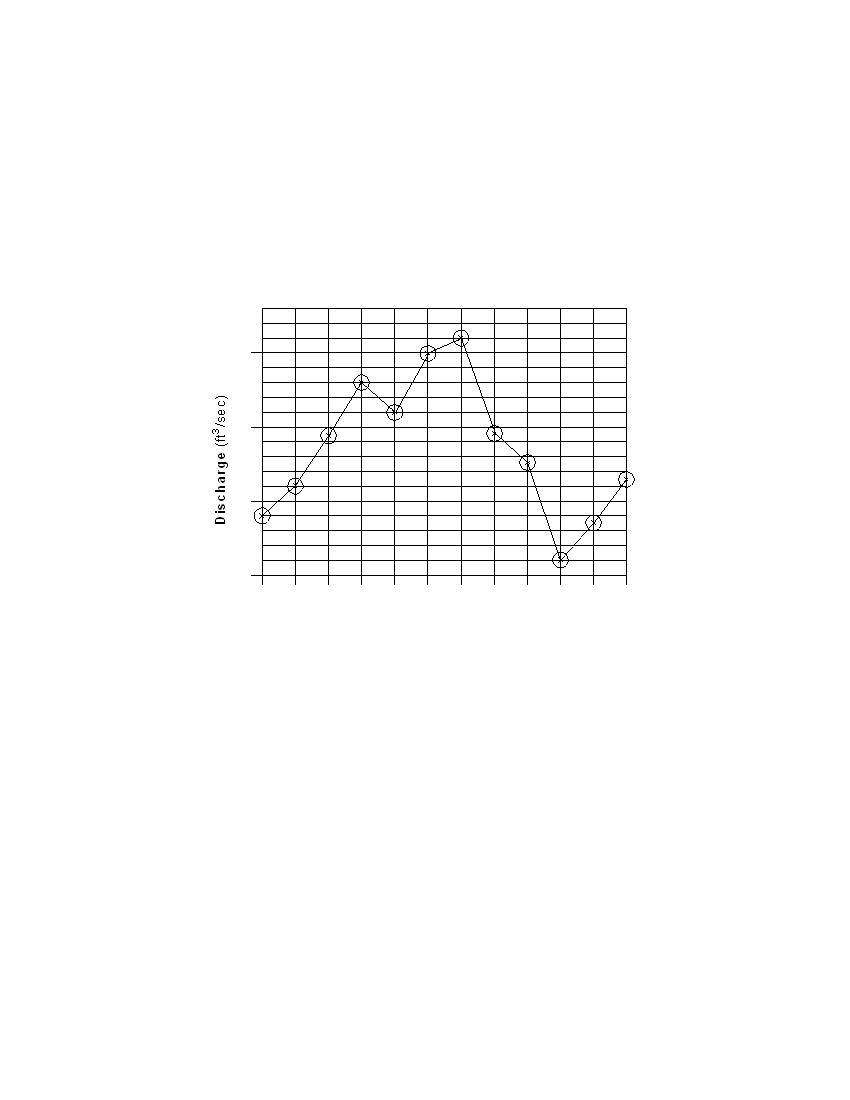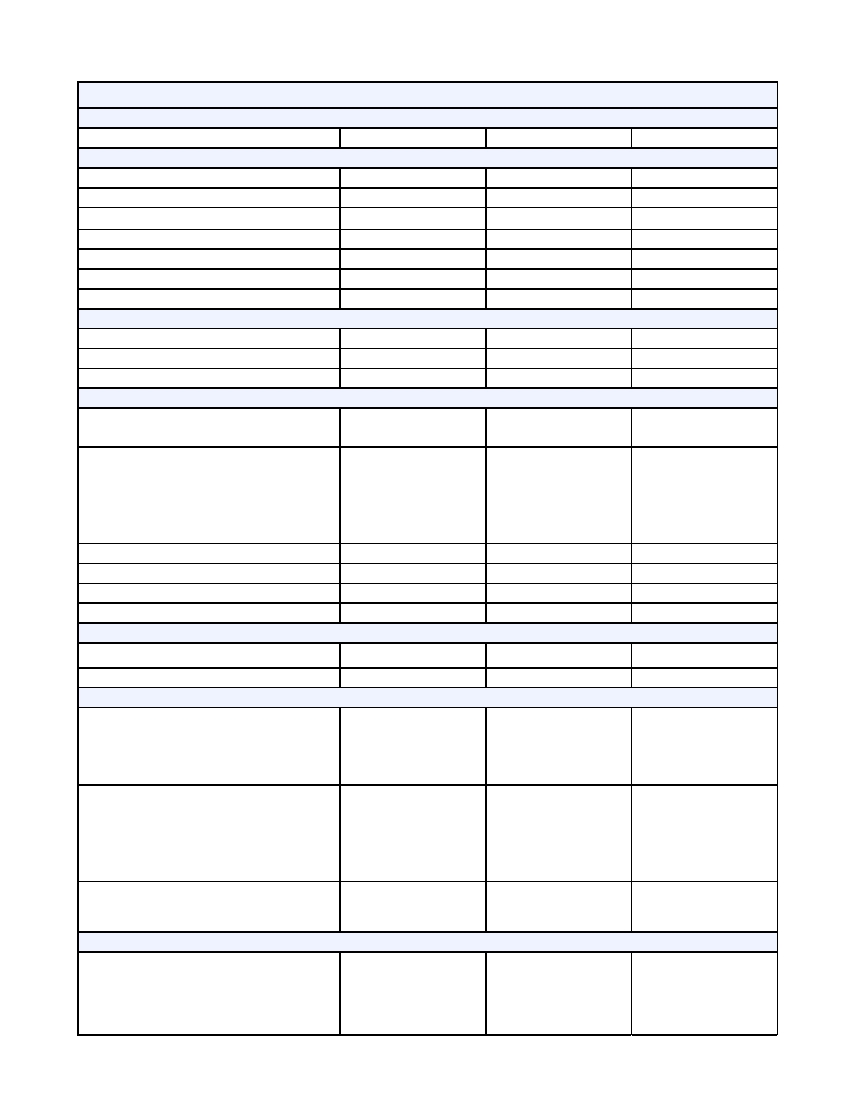
FORTEACHERS ONLY
The University of the State of New York
REGENTS HIGH SCHOOL EXAMINATION
PS–ES PHYSICAL SETTING/EARTH SCIENCE
Wednesday, January 24, 2007 — 9:15 a.m. to 12:15 p.m., only
SCORING KEY AND RATING GUIDE
Directions to the Teacher:
Refer to the directions on page 3 before rating student papers.
Updated information regarding the rating of this examination may be posted on the New York
State Education Department’s web site during the rating period. Check this web site
http://www.emsc.nysed.gov/osa/ and select the link “Examination Scoring Information” for any
recently posted information regarding this examination. This site should be checked before the
rating process for this examination begins and several times throughout the Regents examination
period.
Part A and Part B–1
Allow 1 credit for each correct response.
Part A
Part B–1
1 . . . . . 2. . . . . . .
13 . . . . . 3. . . . . . .
25 . . . . 1. . . . . . .
36 . . . . . 1. . . . . . .
44 . . . . . 3. . . . . . .
2 . . . . . 3. . . . . . .
14 . . . . . 2. . . . . . .
26 . . . . 3. . . . . . .
37 . . . . . 3. . . . . . .
45 . . . . . 2. . . . . . .
3 . . . . . 3. . . . . . .
15 . . . . . 3. . . . . . .
27 . . . . 1. . . . . . .
38 . . . . . 4. . . . . . .
46 . . . . . 3. . . . . . .
4 . . . . . 2. . . . . . .
16 . . . . . 4. . . . . . .
28 . . . . 3. . . . . . .
39 . . . . . 2. . . . . . .
47 . . . . . 1. . . . . . .
5 . . . . . 4. . . . . . .
17 . . . . . 4. . . . . . .
29 . . . . 4. . . . . . .
40 . . . . . 2. . . . . . .
48 . . . . . 1. . . . . . .
6 . . . . . 1. . . . . . .
18 . . . . . 1. . . . . . .
30 . . . . 2. . . . . . .
41 . . . . . 4. . . . . . .
49 . . . . . 1. . . . . . .
7 . . . . . 4. . . . . . .
19 . . . . . 2. . . . . . .
31 . . . . 3. . . . . . .
42 . . . . . 3. . . . . . .
50 . . . . . 4. . . . . . .
Part B–1 Score
8 . . . . . 3. . . . . . .
20 . . . . . 4. . . . . . .
32 . . . . 3. . . . . . .
43 . . . . . 2. . . . . . .
9 . . . . . 1. . . . . . .
21 . . . . . 1. . . . . . .
33 . . . . 4. . . . . . .
10 . . . . . 4. . . . . . .
22 . . . . . 2. . . . . . .
34 . . . . 1. . . . . . .
11 . . . . . 2. . . . . . .
23 . . . . . 4. . . . . . .
35 . . . . 3. . . . . . .
Part A Score
12 . . . . . 4. . . . . . .
24 . . . . . 4. . . . . . .


P HYSICAL S ETTING/ E ARTH S CIENCE – continued
Directions to the Teacher
Follow the procedures below for scoring student answer papers for the Physical Setting/Earth
Science examination. Additional information about scoring is provided in the publication
Information Booklet for Scoring Regents Examinations in the Sciences .
Use only red ink or red pencil in rating Regents papers. Do not correct the student’s work by
making insertions or changes of any kind.
On the detachable answer sheet for Part A and Part B–1, indicate by means of a check mark
each incorrect or omitted answer. In the box provided at the end of each part, record the number
of questions the student answered correctly for that part.
At least two science teachers must participate in the scoring of each student’s responses to the
Part B–2 and Part C open-ended questions. Each of these teachers should be responsible for
scoring a selected number of the open-ended questions on each answer paper. No one teacher is to
score all the open-ended questions on a student’s answer paper.
Students’ responses must be scored strictly according to the Scoring Key and Rating Guide. For
open-ended questions, credit may be allowed for responses other than those given in the rating
guide if the response is a scientifically accurate answer to the question and demonstrates adequate
knowledge as indicated by the examples in the rating guide. In the student’s answer booklet, record
the number of credits earned for each answer in the box printed to the right of the answer lines or
spaces for that question.
Fractional credit is not allowed. Only whole-number credit may be given to a response. Units
need not be given when the wording of the questions allows such omissions.
Raters should enter the scores earned for Part A, Part B–1, Part B–2, and Part C on the
appropriate lines in the box printed on the answer booklet and then should add these four scores
and enter the total in the box labeled “Total Written Test Score.” The student’s score for the
Earth Science Performance Test should be entered in the space provided. Then, the student’s
raw scores on the performance test and written test should be converted to a scaled score by
using the conversion chart that will be posted on the Department’s web site
http://www.emsc.nysed.gov/osa/ on Wednesday, January 24, 2007. The student’s scaled score should
be entered in the labeled box on the student’s answer booklet. The scaled score is the student’s final
examination score.
All student answer papers that receive a scaled score of 60 through 64 must be scored a second
time. For the second scoring, a different committee of teachers may score the student’s paper or
the original committee may score the paper, except that no teacher may score the same open-ended
questions that he/she scored in the first rating of the paper. The school principal is responsible for
assuring that the student’s final examination score is based on a fair, accurate, and reliable scoring
of the student’s answer paper.
Because scaled scores corresponding to raw scores in the conversion chart may change from one
examination to another, it is crucial that for each administration, the conversion chart provided for
that administration be used to determine the student’s final score.
[3]
[OVER]

P HYSICAL S ETTING/ E ARTH S CIENCE – continued
Part B–2
Allow a total of 15 credits for this part. The student must answer all questions in this part.
51 [2] Allow a maximum of 2 credits, allocated as follows:
in the proper format.
and in the proper format.
Note: The feathers for wind speed may be placed on either side of the staff.
Example of a 2-credit response:
36
164
36
52 [2] Allow a maximum of 2 credits, allocated as follows:
— ft/mi
— feet/mile
— ft per mile
53 [1] Allow 1 credit. Acceptable responses include, but are not limited to:
— The slope decreased.
— The gradient decreased from location B to location C .
— The surface was steeper near B and flatter near C .
54 [1] Allow 1 credit. Acceptable responses include, but are not limited to:
— less than 0.0004 cm
— any number given that is less than 0.0004 cm
[4]

P HYSICAL S ETTING/ E ARTH S CIENCE – continued
55 [1] Allow 1 credit for slate.
56 [1] Allow 1 credit. Acceptable responses include, but are not limited to:
— nonvesicular
— coarse
— large crystal
57 [1] Allow 1 credit for an arrow beginning at point B and curving to the northeast or curving to the right.
Allow credit even if the arrow is not curved or if it does not start at point B , but is drawn from
southwest to northeast.
Note: Do not allow credit if the arrow extends past the 60° north latitude line.
Example of a 1-credit response:
90 ° E
120 °
60 °
150 ° E
30 ° E
Sun’s
A
North Pole
rays
180 °
0 °
60 °
150 ° W
30 ° W
B
30 °
120 °
60 °
90 ° W
[5]
[OVER]

P HYSICAL S ETTING/ E ARTH S CIENCE – continued
58 [1] Allow 1 credit. Acceptable responses include, but are not limited to:
— 12 noon
— noon
— 12 p.m.
59 [1] Allow 1 credit. Acceptable responses include, but are not limited to:
— March 20, 21, or 22
— September 21, 22, 23, or 24
— equinox
60 [1] Allow 1 credit. Acceptable responses include, but are not limited to:
— B is located at a lower latitude.
— B is located closer to the equator.
— A is farther north.
— A is located at a greater distance from the latitude receiving direct Sun rays on this day.
61 [1] Allow 1 credit for placing an X whose center falls within the shaded zone of contact metamorphism
shown in the diagram below.
D
C
B
A
Key
Contact
metamorphism
Sedimentary
Igneous
rocks
intrusion
[6]

P HYSICAL S ETTING/ E ARTH S CIENCE – continued
62 [1] Allow 1 credit for calcite.
63 [1] Allow 1 credit. Acceptable responses include, but are not limited to:
— Intrusions are younger than any rock they metamorphose.
— Contact metamorphism can be seen between rock layer D and the igneous intrusion.
[7]
[OVER]

P HYSICAL S ETTING/ E ARTH S CIENCE – continued
Part C
Allow a total of 20 credits for this part. The student must answer all questions in this part.
64 [2] Allow a maximum of 2 credits, allocated as follows:
within the circles shown in the diagram below.
fall within the circles shown in the diagram below.
or
Allow 1 credit if five or six X s are correctly plotted but are not correctly labeled. The center of each
X must fall within the circles shown in the diagram below.
Azimuth Circle
N
360
350
0
10
340
20
30
330
Horizon
40
320
50
310
H
G
60
300
F
E
D
C
70
290
B
A
80
280
W
E
0
6
2
0
0
1
0
5
2
0
1
1
0
4
2
0
2
1
0
3
2
0
3
1
0 2 2
0 4 1
0 1 2
Horizon
0
5 1
0 0
2
0 9 1
0 6 1
0 8 1
0 7 1
S
[8]

P HYSICAL S ETTING/ E ARTH S CIENCE – continued
65 [1] Allow 1 credit. Acceptable responses include, but are not limited to:
— As the latitude of the observer increases, the azimuth decreases.
— As the latitude increases, the sunrise is farther north of east.
66 [1] Allow 1 credit for frozen gases.
67 [1] Allow 1 credit for any value from 150 K to 200 K.
68 [1] Allow 1 credit. Acceptable responses include, but are not limited to:
— As distance from the Sun increases, temperature decreases.
— There is an inverse relationship between distance and temperature.
69 [1] Allow 1 credit for 5.2 AU.
70 [1] Allow 1 credit. Acceptable responses include, but are not limited to:
— Warmer air rises because it is less dense.
— As temperature increases, density decreases.
71 [1] Allow 1 credit for 43.5°F.
72 [1] Allow 1 credit for 100%.
73 [1] Allow 1 credit for any value from 500°C to 1200°C.
74 [1] Allow 1 credit for Indian-Australian Plate.
75 [1] Allow 1 credit. Acceptable responses include, but are not limited to:
— subduction
— convergence
— plate collision
[9]
[OVER]

P HYSICAL S ETTING/ E ARTH S CIENCE – continued
76 [1] Allow 1 credit. Acceptable responses include, but are not limited to:
— move to higher ground
— evacuate
— move inland
77 [1] Allow 1 credit if the center of 10, 11, or 12 X s are plotted within the circles shown on the graph below
and are correctly connected with a line that passes within the circles.
Average Monthly Stream Discharge
70
60
50
40
Jan Feb Mar Apr May Jun Jul Aug Sept Oct Nov Dec
Month
78 [1] Allow 1 credit. Acceptable responses include, but are not limited to:
— As stream discharge increases, suspended sediment increases.
— There is a direct relationship between stream discharge and suspended sediment.
79 [1] Allow 1 credit. Acceptable responses include, but are not limited to:
— Snowmelt in April results in a greater discharge.
— greater rainfall in April
— Saturated ground would cause more runoff in April.
80 [1] Allow 1 credit for stratosphere.
[10]

P HYSICAL S ETTING/ E ARTH S CIENCE – concluded
81 [1] Allow 1 credit. Acceptable responses include, but are not limited to:
— The ozone layer absorbs some of the harmful ultraviolet radiation from the Sun.
— The layer decreases the amount of ultraviolet radiation reaching Earth.
— The ozone protects humans from skin cancer and eye damage.
82 [1] Allow 1 credit. Acceptable responses include, but are not limited to:
— June 20, 21, or 22
— the first day of summer
— summer solstice
[11]

Regents Examination in Physical Setting/Earth Science
January 2007
Chart for Converting Total Test Raw Scores to
Final Examination Scores (Scaled Scores)
The Chart for Determining the Final Examination Score for the January 2007
Regents Examination in Physical Setting/Earth Science will be posted
on the Department’s web site http://www.emsc.nysed.gov/osa/ on
Wednesday, January 24, 2007. Conversion charts provided for previous
administrations of the Regents Examination in Physical Setting/Earth
Science must NOT be used to determine students’ final scores for this
administration.
Submitting Teacher Evaluations of the Test to the Department
Suggestions and feedback from teachers provide an important contribution to the test
development process. The Department provides an online evaluation form for State
assessments. It contains spaces for teachers to respond to several specific questions and to
make suggestions. Instructions for completing the evaluation form are as follows:
1. Go to www.emsc.nysed.gov/osa/exameval.
2. Select the test title.
3. Complete the required demographic fields.
4. Complete each evaluation question and provide comments in the space provided.
5. Click the SUBMIT button at the bottom of the page to submit the completed form.
[12]

Map to Core Curriculum
January 2007 Physical Setting/Earth Science
Question Numbers
Key Ideas/Performance Indicators
Part A
Part B
Part C
Standard 1
Math Key Idea 1
52
64, 69, 71, 77
Math Key Idea 2
16, 30, 34
40
65, 66, 67, 68, 78
Math Key Idea 3
Science Inquiry Key Idea 1
2, 32
44, 60
70, 79
Science Inquiry Key Idea 2
Science Inquiry Key Idea 3
11, 30
54, 55
80
Engineering Design Key Idea 1
Standard 2
Key Idea 1
Key Idea 2
Key Idea 3
Standard 6
Key Idea 1
29, 35
37, 39, 46, 49,
65, 78, 82
53, 63
Key Idea 2
4, 9, 11, 13, 14,
36, 38, 41, 42,
64, 66, 67, 68,
15, 19, 23, 25,
43, 44, 45, 47,
70, 71, 72, 73,
27, 28, 29, 33,
49, 50, 51, 52,
74, 75
34, 35
53, 55, 56, 57,
58, 60, 61, 62, 63
Key Idea 3
43, 45, 47
69
Key Idea 4
Key Idea 5
16
48, 57, 58, 59
70, 71, 75
Key Idea 6
81
Standard 7
Key Idea 1
Key Idea 2
76
Standard 4
Key Idea 1
1, 2, 3, 4, 5, 6, 7,
36, 38, 39, 41,
64, 65, 66, 67,
11, 12, 13, 15, 16 42, 43, 49, 50,
68, 69, 79
57, 58, 59, 60,
61, 62, 63
Key Idea 2
8, 9, 14, 17, 19,
36, 37, 40, 44,
70, 71, 72, 73,
20, 21, 22, 23,
45, 47, 48, 51,
74, 75, 76, 77,
24, 25, 26, 27,
52, 53, 60
78, 80, 81, 82
28, 29, 30, 31,
32, 33, 34, 35
Key Idea 3
10, 18
46, 54, 55, 56,
61, 62
Reference Tables
ESRT 2001 Edition
1, 6, 7, 10, 11,
41, 42, 46, 51,
69, 72, 73, 74, 80
16, 17, 18, 19,
52, 54, 55, 56,
20, 22, 25, 26,
57, 61, 62
27, 30, 32
[13]


